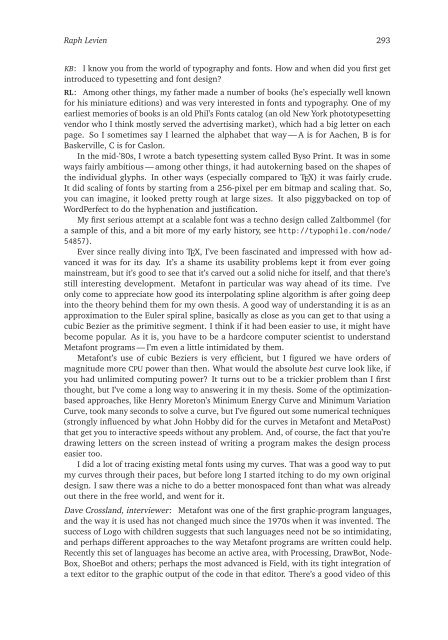Raph Levien - TUG
Raph Levien - TUG
Raph Levien - TUG
Create successful ePaper yourself
Turn your PDF publications into a flip-book with our unique Google optimized e-Paper software.
<strong>Raph</strong> <strong>Levien</strong> 293<br />
KB: I know you from the world of typography and fonts. How and when did you first get<br />
introduced to typesetting and font design?<br />
RL: Among other things, my father made a number of books (he’s especially well known<br />
for his miniature editions) and was very interested in fonts and typography. One of my<br />
earliest memories of books is an old Phil’s Fonts catalog (an old New York phototypesetting<br />
vendor who I think mostly served the advertising market), which had a big letter on each<br />
page. So I sometimes say I learned the alphabet that way — A is for Aachen, B is for<br />
Baskerville, C is for Caslon.<br />
In the mid-’80s, I wrote a batch typesetting system called Byso Print. It was in some<br />
ways fairly ambitious — among other things, it had autokerning based on the shapes of<br />
the individual glyphs. In other ways (especially compared to TEX) it was fairly crude.<br />
It did scaling of fonts by starting from a 256-pixel per em bitmap and scaling that. So,<br />
you can imagine, it looked pretty rough at large sizes. It also piggybacked on top of<br />
WordPerfect to do the hyphenation and justification.<br />
My first serious attempt at a scalable font was a techno design called Zaltbommel (for<br />
a sample of this, and a bit more of my early history, see http://typophile.com/node/<br />
54857).<br />
Ever since really diving into TEX, I’ve been fascinated and impressed with how advanced<br />
it was for its day. It’s a shame its usability problems kept it from ever going<br />
mainstream, but it’s good to see that it’s carved out a solid niche for itself, and that there’s<br />
still interesting development. Metafont in particular was way ahead of its time. I’ve<br />
only come to appreciate how good its interpolating spline algorithm is after going deep<br />
into the theory behind them for my own thesis. A good way of understanding it is as an<br />
approximation to the Euler spiral spline, basically as close as you can get to that using a<br />
cubic Bezier as the primitive segment. I think if it had been easier to use, it might have<br />
become popular. As it is, you have to be a hardcore computer scientist to understand<br />
Metafont programs — I’m even a little intimidated by them.<br />
Metafont’s use of cubic Beziers is very efficient, but I figured we have orders of<br />
magnitude more CPU power than then. What would the absolute best curve look like, if<br />
you had unlimited computing power? It turns out to be a trickier problem than I first<br />
thought, but I’ve come a long way to answering it in my thesis. Some of the optimizationbased<br />
approaches, like Henry Moreton’s Minimum Energy Curve and Minimum Variation<br />
Curve, took many seconds to solve a curve, but I’ve figured out some numerical techniques<br />
(strongly influenced by what John Hobby did for the curves in Metafont and MetaPost)<br />
that get you to interactive speeds without any problem. And, of course, the fact that you’re<br />
drawing letters on the screen instead of writing a program makes the design process<br />
easier too.<br />
I did a lot of tracing existing metal fonts using my curves. That was a good way to put<br />
my curves through their paces, but before long I started itching to do my own original<br />
design. I saw there was a niche to do a better monospaced font than what was already<br />
out there in the free world, and went for it.<br />
Dave Crossland, interviewer: Metafont was one of the first graphic-program languages,<br />
and the way it is used has not changed much since the 1970s when it was invented. The<br />
success of Logo with children suggests that such languages need not be so intimidating,<br />
and perhaps different approaches to the way Metafont programs are written could help.<br />
Recently this set of languages has become an active area, with Processing, DrawBot, Node-<br />
Box, ShoeBot and others; perhaps the most advanced is Field, with its tight integration of<br />
a text editor to the graphic output of the code in that editor. There’s a good video of this

















